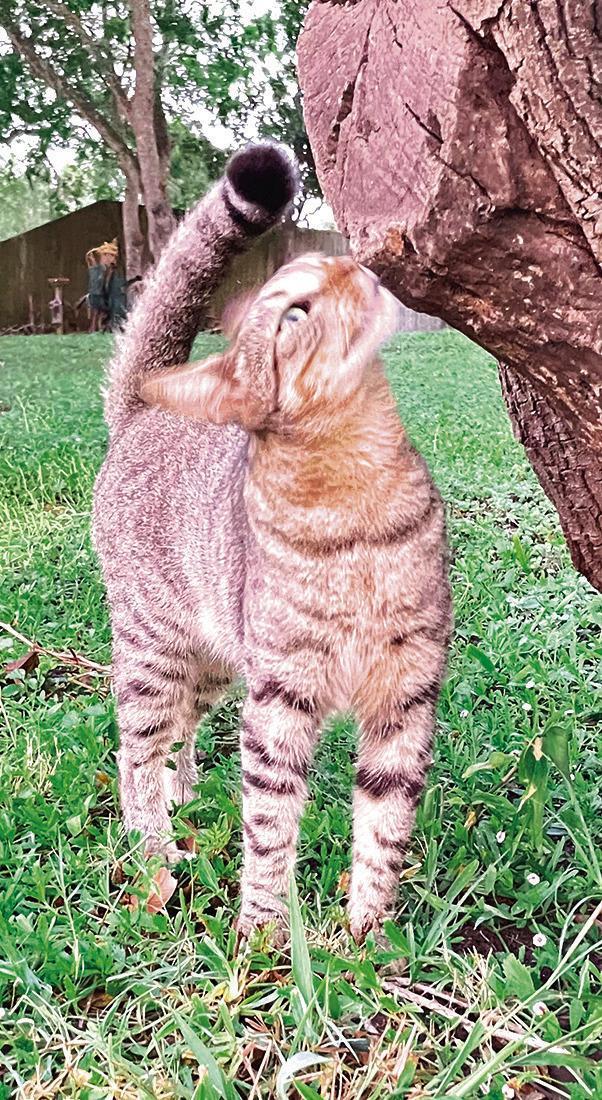
Canyon is a free-range, domestic male cat. Once a semi-feral stray, Canyon was TNR’d before relocating to his new home
in Brazoria.
Photo by Amber Ubernosky
Trap-Neuter-Release: What the future holds for Hays County community cats
Editor’s note: This is part two of a series of articles in relation to the health and welfare of community cats in San Marcos and Hays County.
In early June, at the peak of “kitten season” in Texas, Gov. Greg Abbott signed House Bill 3660 into law. The bipartisan bill extends protection from facing criminal charges when returning sterilized cats to the wild.
The bill aims to protect people who participate in Trap-Neuter-Release (TNR) programs in the state. According to the nonprofit organization For All Animals, a Trap-Neuter-Release program (also known as Trap-Neuter-Return) is “an animal control management practice where community cats are humanely trapped, sterilized by a veterinarian, vaccinated against rabies, eartipped and returned to the trapping location. These cats can range from feral, in which they have no interaction with humans at all — to a community cat, one that is a tame stray living within a human-protected colony.
TNR has been performed for decades by individuals, but is now practiced by shelter employees, veterinarians and animal control officers as well.
HB 3660 moved through legislative channels without challenge, but now the change to the law has rekindled the debate over whether TNR programs are the best way to manage community cat colonies.
Animal advocates like Sharri Boyett, founder of Prevent A Litter of Central Texas (PALS), argue that TNR is the only effective and humane practice in dealing with community cat colonies.
“Putting them back in their colony where there’s at least a food source is the goal, as opposed to allowing them to keep reproducing,” Boyett said.
Perhaps not surprisingly, the strongest opposition to TNR and wild community cat colonies comes from the birding community. Stephen Ramirez, who leads a guided San Marcos Bird Walk on the first Saturday of every month, said that he leans on what the American Bird Conservancy has to say when it comes to the welfare of wild and endangered birds.
According to the ABC, “Trap, Neuter, Release (TNR) is advertised as a tool to reduce feral cat numbers. Unfortunately, TNR programs have been shown to fail to reduce feral cat populations while simultaneously maintaining feral cats on the landscape, where they contribute to wildlife and public health risks.”
The Texas Parks and Wildlife Department supported this conclusion in a brief issued in 2014 regarding the efficacy of TNR programs, citing that “Feral and free-roaming cats alter the ecological balance of a region, as does any other feral non-native (exotic) animal.”
As hunters, cats are particularly rapacious. According to statistics in the TPWD brief, free-roaming domestic cats kill between 1.4 - 3.7 billion birds annually. Those are ordinary house cats and not those in an established wild or feral colony.
“A lot of people say that they should be inside,” Boyett said. “But people leave their cats out. So you either fix them, or just let them keep having more babies.” As an animal welfare advocate for the last twenty years, Boyett has witnessed many changes in public sentiments regarding community cat colonies. “These days, TNR is pretty embraced,” Boyett said. “Even the bird people say, ‘We get it. Now you’re fixing these cats so instead of that many multiplying cats, we have less cats eating the birds. People who love cats certainly don’t want them to be trapped and killed, which is what they’ve been doing for a hundred years, and that never worked. Nature had a vacuum, so those cats actually produced larger litters when you removed some and killed them. They had less competition for food.”
Boyett is referring to a phenomenon in conservation studies called “The Vacuum Effect.”
The website for Alley Cat Allies explains this effect as a territorial vacancy that occurs when a portion of any animal population is removed from their home range. After a temporary period of lower numbers, other members of the same species will return from neighboring areas to utilize the same shelter and resources that sustained the original population.
Ultimately, both sides of the argument hope to achieve the same thing: to protect wild and endangered animals within a given environment. Birding organizations across the state have extensive outreach programs dedicated to protecting wild bird populations.
In San Marcos and the greater Hays County area, animal advocates are also working on programs that will further address the issue of unspayed community cats before they add to the already burgeoning feline population.
This is Part Two in a series of articles about current initiatives regarding pet welfare in San Marcos and Hays County. Part three will discuss these developments in more detail.











